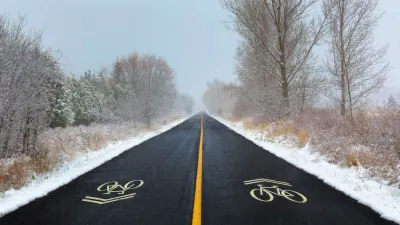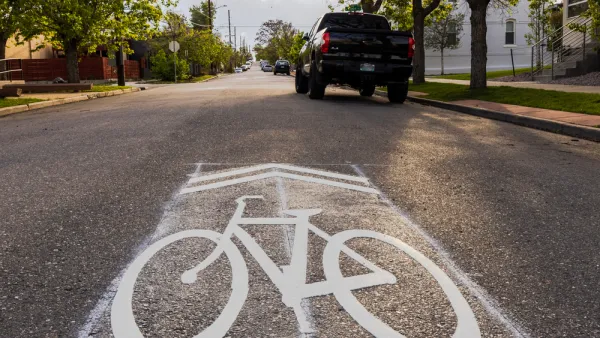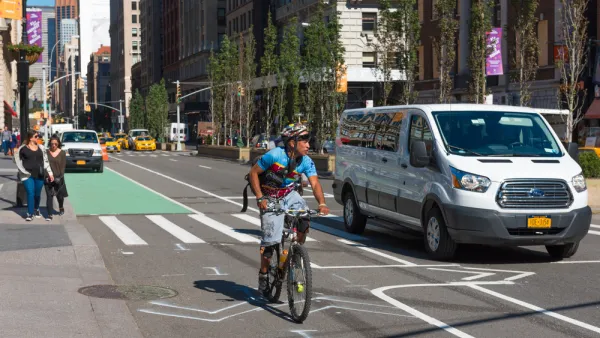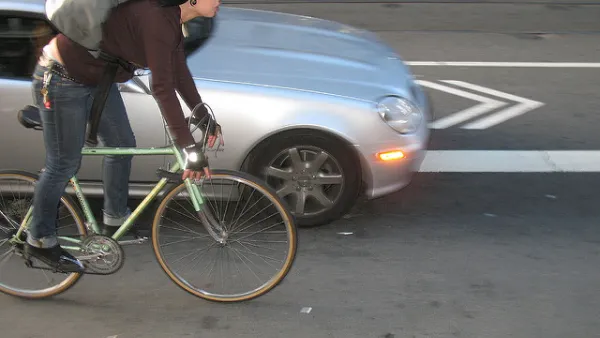The lane marking was meant to raise awareness and instill shared respect among drivers and cyclists. But their inefficiency has led supporters to denounce sharrows, pushing instead for more robust bike infrastructure that truly protects riders.

Dave Snyder, senior director for infrastructure at PeopleForBikes and the former executive director of the California Bicycle Coalition, was an early and enthusiastic supporter of the sharrow, a lane marking designed to make drivers aware that they are sharing space with bikes and encourage people on bikes to claim the lane rather than riding in the dangerous ‘door zone.’
According to Snyder, “I thought the sharrow would educate bicyclists to stay out of the ‘door zone’ and usher in a new era of safer streets, one where motorists would patiently wait behind bicyclists ‘taking the lane’ because this painted symbol made it clear they had the right to do so.” But Snyder admits the markings are clearly not enough to change behavior. “Sharrow or no sharrow, most people on bikes dangerously hug the edge of the roadway, squeezing themselves into the door zone to avoid blocking car traffic.” Now, after two decades of data and lived experience, Snyder believes that sharrows “are great for navigation and, perhaps, concentrating riders on certain streets — that’s about it.”
If anything, Snyder points out that sharrows have an unintended effect that is “insulting” to the bike-riding public: “They allow officials to take credit for doing something for bicycle safety without impacting car traffic, even though that something is next to nothing.”
Snyder emphasizes that bike advocates like him and his current organization, PeopleForBikes, now acknowledge the failures of sharrows and have stopped recommending them. “Today, we know so much more about what it takes to make our streets safer for bicycling. We need separate bike paths; we need protected bike lanes on busy roads; and where the lanes are shared, we need actual speeds reduced to 20 mph or slower.”
FULL STORY: Big Admission: ‘I Was Wrong About Sharrows’

Analysis: Cybertruck Fatality Rate Far Exceeds That of Ford Pinto
The Tesla Cybertruck was recalled seven times last year.

National Parks Layoffs Will Cause Communities to Lose Billions
Thousands of essential park workers were laid off this week, just before the busy spring break season.

Retro-silient?: America’s First “Eco-burb,” The Woodlands Turns 50
A master-planned community north of Houston offers lessons on green infrastructure and resilient design, but falls short of its founder’s lofty affordability and walkability goals.

Test News Post 1
This is a summary

Analysis: Cybertruck Fatality Rate Far Exceeds That of Ford Pinto
The Tesla Cybertruck was recalled seven times last year.

Test News Headline 46
Test for the image on the front page.
Urban Design for Planners 1: Software Tools
This six-course series explores essential urban design concepts using open source software and equips planners with the tools they need to participate fully in the urban design process.
Planning for Universal Design
Learn the tools for implementing Universal Design in planning regulations.
EMC Planning Group, Inc.
Planetizen
Planetizen
Mpact (formerly Rail~Volution)
Great Falls Development Authority, Inc.
HUDs Office of Policy Development and Research
NYU Wagner Graduate School of Public Service




























